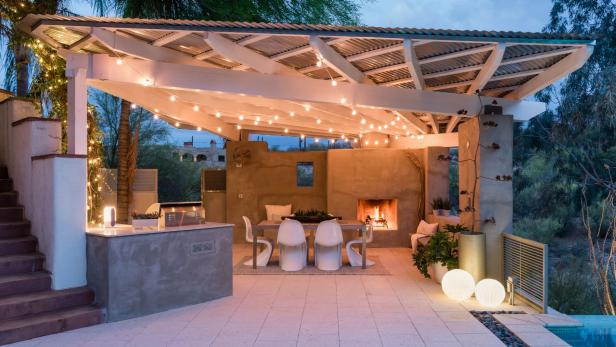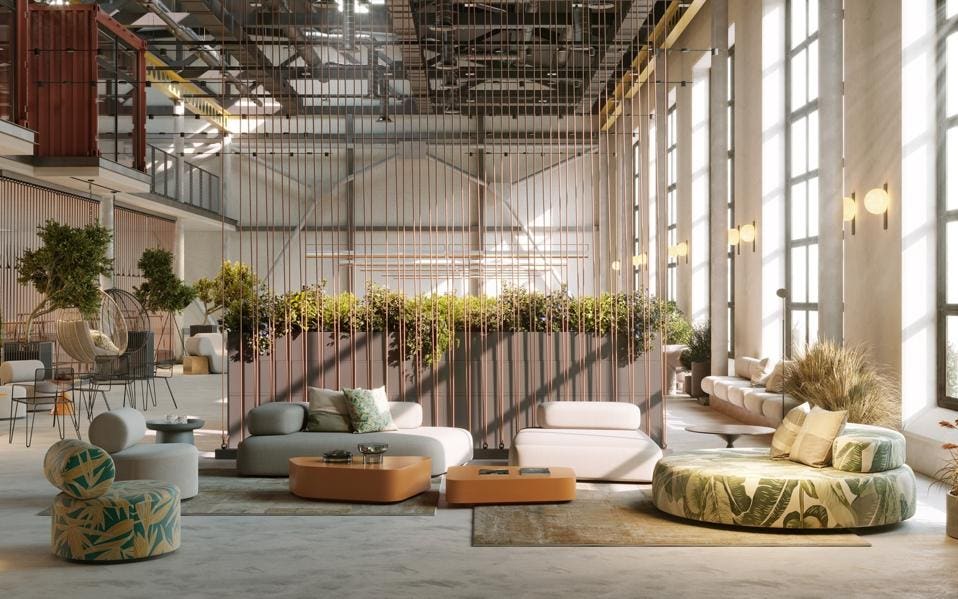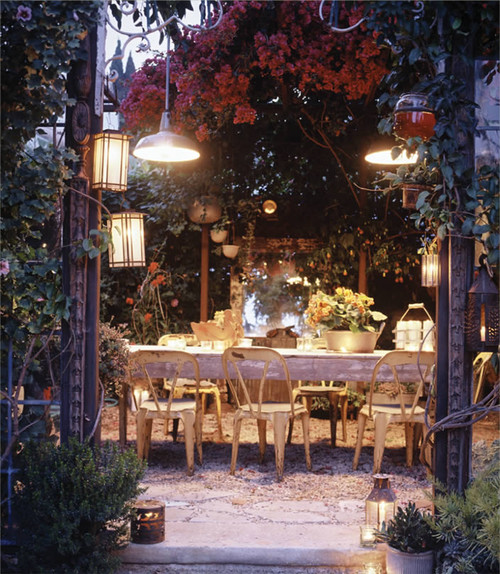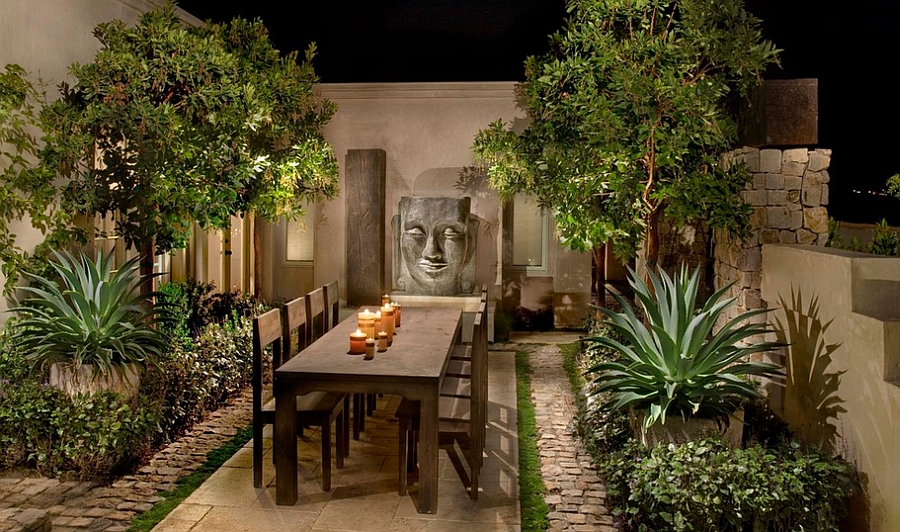Table of Contents
In the world of modern living, outdoor spaces have become an extension of our homes, offering opportunities for relaxation, entertainment, and, of course, dining. Patios, in particular, have evolved from simple concrete slabs to enchanting outdoor sanctuaries where culinary experiences are savored and memories are made. In this article, we explore the art of patio design and share tips on how to create an inviting outdoor dining space that beckons you and your guests to linger.
Expanding on the concept of patio design and outdoor dining spaces:
Purposeful Layout: The layout of your patio should align with its intended use. Consider how you plan to use the space—whether it’s for dining, lounging, gardening, or a combination of activities. Thoughtful design can create distinct zones within the patio, ensuring that each area serves its purpose effectively.
Comfortable Seating: Comfort is paramount in outdoor dining spaces. Invest in high-quality, weather-resistant furniture with comfortable cushions and seating. Options range from classic wooden sets to contemporary rattan or metal designs, allowing you to choose a style that complements your outdoor aesthetic.
Shade and Shelter: To make your patio inviting in various weather conditions, incorporate shade options such as umbrellas, pergolas, or retractable awnings. These additions not only provide relief from the sun but also create an appealing visual element.
Ambient Lighting: Well-planned lighting transforms your patio into an enchanting space after dark. String lights, lanterns, sconces, and even fire pits can set the mood for cozy evenings. Consider both functional task lighting for dining and ambient lighting for overall atmosphere.
Greenery and Landscaping: Plants and landscaping can soften the edges of your patio and bring nature closer to your dining experience. Container gardens, potted plants, or vertical gardens can add a touch of greenery and fragrance. Strategically placed trees and shrubs can provide privacy and natural beauty.
Outdoor Kitchen and Grill: Elevate your outdoor dining with the convenience of an outdoor kitchen or grill area. This allows you to prepare and cook meals while staying connected with your guests. It’s a practical addition for avid outdoor entertainers.
Materials and Finishes: The choice of materials and finishes for your patio plays a significant role in its overall aesthetic. Consider durable and weather-resistant materials such as natural stone, concrete pavers, or composite decking. These materials not only look great but also require minimal maintenance.
Personalized Decor: Personalize your outdoor space with decorative elements that reflect your style. This can include colorful outdoor rugs, throw pillows, table settings, and artwork. These accents add vibrancy and character to your patio.
Soundscapes and Water Features: The soothing sound of flowing water or gentle background music can enhance the ambiance of your patio. Water features like fountains or ponds, as well as outdoor speakers, can create a tranquil atmosphere for dining and relaxation.
Seasonal Flexibility: Design your patio to be adaptable to different seasons. Consider the use of outdoor heaters or fire pits for cooler months and portable fans or misters for the summer. Modular furniture and removable decor can also be easily switched out with the changing seasons.
Accessibility and Safety: Ensure that your patio is accessible and safe for all users. This includes providing non-slip surfaces, well-maintained pathways, and proper lighting to prevent accidents and injuries.
Sustainability: Consider eco-friendly design elements, such as using reclaimed materials or installing rain barrels for water conservation. Sustainable landscaping practices and native plants can also promote environmental harmony in your outdoor space.
In conclusion, designing an inviting outdoor dining space on your patio is a creative endeavor that combines functionality with aesthetics. A well-designed patio not only extends your living space but also becomes a haven where you, your family, and guests can savor meals, unwind, and create cherished memories amid the beauty of the outdoors.
For a comprehensive look at this subject, we invite you to read more on this dedicated page: LITTLE TOKYO
Start with a Vision
Before diving into the practicalities of patio design, it’s crucial to establish a vision for your outdoor dining area. Consider the following questions:
How do you envision using the space? Is it for intimate family dinners, large gatherings, or quiet moments of solitude?
What’s your style? Do you prefer a rustic, bohemian, modern, or classic design?
What’s your climate like? Consider the weather patterns in your region and plan accordingly, with options for shade and protection.
Having a clear vision will guide your design choices and ensure that your patio reflects your unique tastes and needs.
Before diving into the practicalities of patio design, it’s crucial to establish a vision for your outdoor dining area. This initial step is the cornerstone of creating a space that not only looks appealing but also meets your specific needs and preferences. Here are some key considerations to help you craft a clear and inspiring vision for your patio:
1. Functionality: Begin by defining how you intend to use the space. Are you envisioning intimate family dinners, large gatherings with friends, or perhaps a peaceful retreat for personal relaxation? Understanding the primary function of your patio will influence its layout, seating arrangements, and overall design.
2. Style and Aesthetics: Consider your personal style and the atmosphere you want to create. Do you lean towards rustic charm, embracing natural materials like wood and stone? Or does a modern, minimalist design with sleek lines and contemporary furnishings resonate with you? Your chosen style will set the tone for the entire space.
3. Climate Considerations: Take into account the climate of your region. Are you in a sunny, hot area, a chilly and rainy climate, or somewhere in between? Your local weather patterns will impact your choice of materials, shading options, and the need for weatherproof furniture. For sun-drenched locations, sunshades, pergolas, or umbrellas may be essential, while waterproof materials are vital for rainy regions.
4. Size and Layout: Determine the available space for your patio. Measure the area accurately and consider any existing features, such as trees, shrubs, or structures. This will help you plan the layout, ensuring that your design is proportional to the space and allows for comfortable movement.
5. Lighting: Don’t forget about lighting, both for practicality and ambiance. Decide whether you want soft, atmospheric lighting for evenings, task lighting for dining, or a combination of both. Lighting can significantly enhance the mood and usability of your patio.
6. Budget: Establish a realistic budget for your patio project. Knowing your financial constraints from the outset will guide your material and furniture choices, preventing overspending and ensuring that your design aligns with your financial goals.
7. Sustainability: Consider eco-friendly options for your patio. Sustainable materials, water-efficient landscaping, and energy-efficient lighting can reduce your environmental footprint and enhance the long-term sustainability of your outdoor space.
8. Personal Touch: Lastly, infuse your patio design with personal touches that reflect your unique tastes and interests. Whether it’s colorful cushions, vibrant planters, artwork, or decorative elements, these details will make the space feel uniquely yours.
By addressing these questions and considerations, you’ll create a comprehensive vision for your patio that serves as a roadmap for the design process. With a clear understanding of how you want to use the space, your preferred style, and a plan tailored to your climate and budget, you’ll be well-prepared to make informed design choices that result in a patio that perfectly suits your needs and reflects your individuality.
For a comprehensive look at this subject, we invite you to read more on this dedicated page: Walker Art Center Wurtele Upper Garden | 2018 ASLA Professional …

Layout and Flow
The layout of your patio plays a vital role in creating an inviting dining space. Consider these layout tips:
The layout of your patio plays a vital role in creating an inviting dining space, setting the stage for memorable gatherings and relaxing moments. When designing your outdoor oasis, consider these layout tips to make the most of your space and enhance the overall dining experience:
Flow and Accessibility: Start by ensuring easy access to your patio dining area from your home’s interior. A seamless flow between indoor and outdoor spaces makes it convenient for you and your guests to move between the two, especially when carrying food and drinks. Consider installing sliding glass doors, a wide doorway, or a well-defined pathway for a smooth transition.
Dining Zones: Divide your patio into distinct zones to accommodate various activities. Create a designated dining area with a dining table and chairs that suit your style and space constraints. Separating this zone from other areas, like a lounging or cooking area, helps define the purpose of each space.
Proximity to Kitchen: If possible, position your dining area close to your outdoor kitchen or cooking setup. This proximity simplifies meal preparation and serving, allowing you to interact with your guests while grilling or plating dishes. It also minimizes the distance you need to travel with hot dishes.
Shade and Shelter: Provide shade options to protect diners from harsh sunlight or unexpected rain. Consider installing a pergola, patio umbrella, or retractable awning. These additions not only offer relief from the elements but also add a touch of style to your outdoor space.
Furniture Arrangement: Choose patio furniture that suits your desired ambiance. For a cozy, intimate setting, opt for a smaller table and comfortable chairs. If you frequently host larger gatherings, a spacious, expandable dining table with stackable chairs may be more suitable.
View and Privacy: Take advantage of scenic views or create privacy screens with plants, trellises, or decorative partitions. Whether you’re dining in the heart of a bustling city or a serene countryside, your patio layout should enhance the environment while providing a sense of seclusion when needed.
Lighting: Plan for adequate lighting to extend your dining hours into the evening. Consider string lights, lanterns, wall sconces, or built-in LED fixtures. Layering different types of lighting can create a warm and inviting atmosphere.
Comfort and Cushions: Invest in comfortable seat cushions and outdoor-friendly textiles. These additions not only increase comfort but also add pops of color and style to your dining area. Ensure that cushions are designed to withstand the elements.
Flexibility: Keep your patio layout flexible by choosing furniture that can be easily rearranged. This versatility allows you to adapt your space for different occasions, from intimate dinners to larger gatherings or even solo moments of relaxation.
Personal Touch: Infuse your patio with your personal style by incorporating decorative elements like potted plants, outdoor artwork, or a statement rug. These finishing touches can transform a functional dining space into an inviting oasis that reflects your unique taste.
Remember that the ideal patio layout is one that caters to your lifestyle and preferences. By considering these layout tips and customizing them to suit your needs, you can create a patio dining space that becomes a cherished extension of your home, perfect for sharing meals, making memories, and enjoying the great outdoors.
Looking for more insights? You’ll find them right here in our extended coverage: How to Design an Outdoor Dining Room with Furniture – Patio …

Dining Area
Determine the location of your dining table and chairs. Ensure there’s ample space for movement and pulling out chairs comfortably.
Selecting the perfect location for your dining table and chairs is a pivotal step in creating a welcoming and functional dining area. Beyond aesthetics, it’s essential to consider practical aspects to enhance the overall dining experience:
Natural Lighting: If possible, position your dining area near a source of natural light, like a window or sliding door. Daylight adds warmth and creates a pleasant atmosphere for meals. It also reduces the need for artificial lighting during the day.
Proximity to the Kitchen: While it’s ideal to have the dining area adjacent to the kitchen, ensure it’s not too close to cooking areas to prevent unwanted heat and odors. This proximity makes serving meals more convenient and encourages easy access for setting the table.
Traffic Flow: Plan the dining area to avoid blocking major pathways or creating congestion in your home. Ensure that there’s enough space for people to move freely around the dining table, even when chairs are pulled out. This prevents disruptions during meals and ensures comfort.
View and Ambiance: Consider the view from the dining area. A beautiful outdoor view or an aesthetically pleasing interior can enhance the dining experience. Additionally, set the mood with appropriate lighting fixtures, wall decor, or plants to create a cozy and inviting ambiance.
Furniture Size and Shape: The size and shape of your dining table should be proportional to the room. For smaller spaces, a round or square table may work better, while larger rooms can accommodate rectangular or oval tables. Ensure that there’s enough clearance between the table and walls or other furniture.
Accessibility: If you have family members with mobility challenges, prioritize accessibility when placing the dining table. Leave sufficient space for wheelchair access and consider installing handrails if needed.
Temperature Comfort: Be mindful of temperature variations in the chosen dining area. Avoid placing the table in drafty or excessively sunny spots. Adequate heating and cooling should be available to ensure year-round comfort during meals.
Functionality: Consider the versatility of the dining area. Can it double as a workspace or a place for family gatherings beyond regular meals? Versatile furniture and storage solutions can maximize the functionality of the space.
Aesthetics and Decor: Match the dining area’s decor and color scheme with the overall design of your home. Coordinating furniture, table settings, and decor elements can create a cohesive and visually pleasing dining space.
Seating Arrangement: When arranging chairs, leave enough space between them for comfortable seating and movement. Ensure that chairs can be pushed in completely under the table when not in use to save space.
Noise Considerations: Keep noise levels in mind. If your dining area is near a noisy area, consider adding rugs or acoustic elements to dampen sound and create a more peaceful dining environment.
Flexibility: Finally, consider the flexibility of your dining area setup. Will it accommodate different group sizes, such as intimate family dinners or larger gatherings? Modular or extendable dining tables can offer adaptability.
By carefully determining the location of your dining table and chairs, taking into account these practical considerations, you can create a dining space that is not only aesthetically pleasing but also functional, comfortable, and versatile—a place where meals become cherished moments shared with loved ones.
To expand your knowledge on this subject, make sure to read on at this location: 77 Patio Decor Ideas – Stylish Outdoor Patio Designs and Photos

Cooking Zone
If you have an outdoor kitchen or grill, position it conveniently near the dining area for easy access while cooking.
Positioning your outdoor kitchen or grill conveniently near the dining area is a strategic decision that can greatly enhance the functionality and enjoyment of your outdoor living space. Here are some additional considerations and benefits to keep in mind:
Efficient Meal Preparation: Placing your outdoor kitchen or grill close to the dining area reduces the distance and effort required to transport food and utensils. This efficiency not only saves time but also ensures that you can keep a watchful eye on your cooking while still engaging with guests or family members.
Seamless Hosting: Hosting outdoor gatherings becomes a breeze when the cooking station is within arm’s reach of the dining area. You can effortlessly transition between cooking and entertaining, ensuring that your guests feel comfortable and well-attended to.
Safety First: Proximity to the dining area allows you to maintain a safe cooking environment. You can quickly access fire extinguishing equipment, first aid supplies, and safety gear if needed. Plus, it’s easier to keep children and pets away from the cooking area when it’s within sight.
Enhanced Social Interaction: Cooking outdoors is a communal experience, and having the kitchen or grill nearby fosters social interaction. You can chat with guests, share cooking tips, and enjoy the camaraderie that comes with preparing meals together.
Effortless Dining: Once the meal is ready, you can effortlessly transfer it to the dining area without having to navigate a long distance. This convenience ensures that your food remains hot and fresh when it reaches the table.
Multi-Functional Space: An outdoor kitchen located near the dining area can serve as a multi-functional hub. It can double as a bar, a serving station, or even a buffet area during larger gatherings, making the most of the available space.
Aesthetically Pleasing Design: Consider the aesthetics of your outdoor space. Integrating the kitchen or grill into the overall design plan ensures a cohesive and visually pleasing environment. You can use complementary materials, colors, and landscaping to create a harmonious outdoor living area.
Weather Considerations: Be mindful of your region’s weather conditions when positioning the outdoor kitchen. Providing adequate shade or shelter can make outdoor cooking and dining enjoyable year-round, regardless of the elements.
Storage and Organization: Alongside the kitchen or grill, consider incorporating storage solutions and organization features. Cabinets, drawers, and shelving can help keep cooking utensils, spices, and accessories neatly organized and easily accessible.
Lighting: Don’t forget about lighting for both the cooking area and the dining space. Adequate illumination ensures safe and enjoyable outdoor cooking and dining after dark.
In conclusion, strategically situating your outdoor kitchen or grill near the dining area is a practical and enjoyable choice for your outdoor living space. It promotes efficiency, safety, and social interaction while enhancing the overall aesthetics and functionality of your outdoor environment. Whether you’re cooking for a small family dinner or hosting a larger gathering, this arrangement ensures that your outdoor meals are a delightful experience for all.
You can also read more about this here: Design an Outdoor Oasis to Enjoy with Family and Friends …

Conversation Nooks
Create cozy nooks with seating where guests can relax before or after the meal.
Designing cozy nooks with comfortable seating is a thoughtful addition to any space, whether it’s a restaurant, cafe, or even a home. These inviting corners provide a multitude of benefits beyond just a place to relax before or after a meal. Here’s why they are cherished elements in various environments:
1. Warmth and Comfort: Cozy nooks exude an inviting warmth and comfort that envelops guests. Plush cushions, soft throws, and well-chosen lighting create an ambiance that encourages relaxation and contentment.
2. Conversation Hubs: These nooks serve as intimate conversation hubs where friends, family, or acquaintances can engage in meaningful discussions. The comfortable seating arrangement fosters closeness and encourages dialogue.
3. Versatile Functionality: Cozy nooks are versatile spaces that can serve multiple purposes. They are perfect for enjoying a cup of coffee, reading a book, or even catching up on work in a relaxed setting. This versatility enhances the overall experience of the space.
4. Privacy and Solitude: For those seeking solitude or a moment of privacy, cozy nooks offer a sanctuary. It’s a place where one can retreat from the hustle and bustle of a busy environment and find solace in their thoughts.
5. Aesthetic Appeal: Well-designed nooks contribute to the aesthetic appeal of the surroundings. Thoughtful selection of furniture, colors, and decor elements can make these areas visually pleasing, adding to the overall ambiance of the space.
6. Connection to Nature: In outdoor settings, cozy nooks can be strategically placed to offer a connection to nature. Whether it’s a garden corner, a patio with a view, or a deck overlooking a tranquil landscape, these nooks provide a sense of oneness with the natural world.
7. Personalization: Cozy nooks allow for personalization and self-expression. Guests can choose their favorite corner, select their preferred seating arrangement, or even bring their own book or blanket to make the space uniquely theirs.
8. Extended Stay: In hospitality settings, such as hotels or bed-and-breakfasts, these nooks provide guests with a reason to extend their stay. A cozy corner can be a compelling incentive for guests to linger, enhancing their overall experience.
9. Designated Waiting Areas: In restaurants or cafes, cozy nooks can serve as waiting areas for guests who arrive early or have to wait for a table. This ensures that even during busy times, guests are comfortable and well-cared for.
10. Cultural and Traditional Significance: In some cultures, cozy nooks are an integral part of traditions. For example, the concept of a “tea corner” in many Middle Eastern cultures symbolizes hospitality and offers guests a welcoming space for tea and conversation.
11. Promoting Wellness: Cozy nooks can contribute to wellness and mental health. These spaces offer respite, allowing individuals to recharge and destress in a soothing environment.
Incorporating cozy nooks with inviting seating into a space is a thoughtful design choice that enhances the overall experience, whether it’s in a dining establishment, a public venue, or a personal living space. These nooks provide a tangible sense of comfort, connection, and relaxation, making them cherished corners that leave a lasting impression on those who encounter them.
Additionally, you can find further information on this topic by visiting this page: 47 Small Patio Ideas That Enhance Even Tiny Outdoor Spaces …

Choose the Right Furniture
Outdoor dining furniture should be both functional and comfortable. Opt for durable materials like teak, metal, or resin wicker that can withstand the elements. Cushioned seats and throw pillows add comfort and style. Don’t forget to provide plenty of seating to accommodate varying group sizes.
Outdoor dining furniture should be both functional and comfortable, as it plays a pivotal role in creating a welcoming and enjoyable outdoor dining experience. Here are some considerations and ideas to extend on the concept:
Weather Resistance: Choosing the right materials is essential for outdoor furniture longevity. Opt for materials like teak, metal, or resin wicker, as they are known for their durability and ability to withstand various weather conditions. Teak, in particular, weathers gracefully, acquiring a beautiful silver patina over time.
Low-Maintenance Options: To ensure your outdoor dining area remains inviting without constant upkeep, consider low-maintenance materials. Aluminum and powder-coated steel are resistant to rust and require minimal maintenance. Resin wicker is easy to clean and doesn’t fade in the sun.
Comfort is Key: To encourage guests to linger and enjoy their meals, invest in comfortable seating options. Cushioned seats and throw pillows not only add comfort but also bring a touch of style and personalization to your outdoor space. Look for outdoor-rated cushions that resist mold and mildew.
Ergonomics: Pay attention to the ergonomics of the seating. Chairs with proper back support and a comfortable angle encourage diners to relax and savor their meals. Consider chairs with arms for added comfort during extended dining sessions.
Table Size and Shape: The dining table should be spacious enough to comfortably accommodate the number of diners you expect. Consider round tables for intimate gatherings and rectangular tables for larger groups. Extending tables can be a versatile choice when you need to adjust the seating capacity.
Shade Options: To enhance comfort during hot, sunny days, provide shade options. Consider adding a patio umbrella or a pergola with a retractable canopy to shield diners from the sun’s rays.
Versatile Seating: In addition to traditional dining chairs, consider adding some versatile seating options. Benches or built-in seating along the perimeter of your outdoor dining area can maximize space and provide flexible seating arrangements.
Ambiance and Lighting: To create an inviting evening atmosphere, incorporate lighting into your outdoor dining space. String lights, lanterns, or even candles can add a warm and inviting glow to your outdoor dinners.
Storage Solutions: Depending on the climate, consider storage solutions for your outdoor furniture during harsh weather seasons. Covers or storage sheds can help prolong the life of your furniture.
Personal Touch: Add your personal style and flair to the outdoor dining area with decorative elements such as table runners, placemats, and centerpieces. These small touches can make a big difference in the overall ambiance.
Accessibility: Ensure that your outdoor dining setup is accessible to all, including individuals with mobility challenges. Consider ramps, wider pathways, and accessible seating options to accommodate diverse guests.
Greenery and Landscaping: Surround your outdoor dining area with lush greenery, potted plants, or a garden. This not only enhances the aesthetics but also creates a natural barrier and a sense of enclosure for a more intimate dining experience.
In summary, outdoor dining furniture should strike a balance between functionality and comfort, with careful consideration of materials, seating ergonomics, and personal touches. A well-appointed outdoor dining area invites guests to relax, connect, and savor the pleasures of dining al fresco, making it an essential part of any outdoor living space.
For additional details, consider exploring the related content available here How to Choose the Right Outdoor Furniture – The New York Times

Create Ambiance
Ambiance sets the mood for outdoor dining. Here are some elements to consider:
Ambiance plays a pivotal role in shaping the atmosphere and overall experience of outdoor dining. The interplay of various elements can transform a meal into a memorable occasion. When planning an outdoor dining experience, here are some key elements to consider:
Location and Setting: The choice of location sets the stage for your outdoor dining adventure. Whether it’s a beachfront restaurant, a charming garden patio, a rooftop terrace, or a rustic countryside picnic spot, the setting can greatly influence the ambiance. Consider the backdrop, the views, and the natural surroundings, as they will all contribute to the overall atmosphere.
Lighting: Lighting is a crucial element in creating ambiance, especially for evening dining. Soft, warm lighting can lend a romantic and intimate feel, while brighter lights may be more suitable for casual gatherings. Candles, lanterns, string lights, and even fire pits can add a touch of magic to the setting.
Music and Sound: The choice of music or natural soundscape can greatly impact the mood. Soft jazz melodies, acoustic tunes, or the soothing sounds of nature can enhance the dining experience. Ensure that the volume is appropriate for conversation without overpowering it.
Furniture and Decor: The selection of outdoor furniture, table settings, and decor should align with the desired ambiance. Comfortable seating, well-dressed tables, and thoughtful decorations can elevate the visual appeal and comfort of the space. Consider the use of tablecloths, centerpieces, and tableware that complement the setting.
Temperature Control: Depending on the climate and time of day, temperature control is essential for guest comfort. In warmer weather, provide shade or umbrellas, and consider fans or misters. For cooler evenings, offer blankets, heaters, or fire pits to keep guests cozy.
Scents: The aroma of the surrounding environment can be a powerful element in setting the mood. Consider fragrant flowers, herbs, or scented candles that enhance the dining experience without overwhelming the senses.
Thematic Elements: If you’re aiming for a specific theme or atmosphere, incorporate thematic elements into the decor and menu. For example, a Mediterranean-inspired setting might feature blue and white colors, while a rustic farm-to-table experience could include wooden accents and earthy tones.
Privacy and Seating Arrangement: Ensure that the seating arrangement allows for privacy and comfort. Arrange tables to accommodate the number of guests while maintaining an intimate feel. Create cozy nooks for smaller groups or romantic dinners.
Natural Elements: Embrace the natural surroundings by integrating them into the ambiance. Incorporate plants, flowers, or natural materials that harmonize with the environment. Water features, like fountains or ponds, can add a soothing element.
Service and Staff: Friendly and attentive staff members who understand the importance of ambiance can contribute significantly to the overall experience. Ensure that the service style aligns with the desired atmosphere, whether it’s casual and relaxed or formal and attentive.
In conclusion, crafting the perfect ambiance for outdoor dining involves thoughtful consideration of these elements. By paying attention to location, lighting, music, decor, comfort, and more, you can create an enchanting atmosphere that enhances the enjoyment of the meal and leaves a lasting impression on your guests. Ambiance transforms dining into a multisensory experience, where every detail contributes to the overall magic of the moment.
Looking for more insights? You’ll find them right here in our extended coverage: How To Choose the Right Outdoor Restaurant … – CAST Lighting

Lighting
Incorporate ambient lighting with string lights, lanterns, or even a chandelier for evening dining. Task lighting over the dining table is essential for practicality.
Incorporating lighting into your dining area is not just a matter of functionality; it’s an opportunity to set the mood and create a captivating atmosphere for your evening dining experiences. Here’s how you can make the most of lighting:
Ambient Glow: String lights, lanterns, or a chandelier can transform your outdoor dining space into a magical wonderland as the sun sets. These ambient lighting options cast a warm, inviting glow that adds charm and a touch of romance to the setting.
Customization: Choose lighting fixtures that align with your outdoor dining theme or personal style. For a rustic feel, opt for vintage lanterns or Edison-style string lights. Modern outdoor chandeliers can complement contemporary designs, while paper lanterns can evoke an exotic ambiance.
Versatility: Don’t limit yourself to a single lighting source. Mixing different types of lighting can create depth and visual interest. String lights intertwined with greenery or hanging lanterns can add layers of illumination, making the space feel dynamic and enchanting.
Candlelit Elegance: Candles are an elegant addition to any outdoor dining setup. Line the table with candleholders or place them in hurricane lanterns for a touch of sophistication. The flickering candlelight adds an intimate and cozy ambiance.
Task Lighting: While ambient lighting sets the mood, don’t forget about practicality. Task lighting over the dining table is essential for ensuring that diners can see their meals and engage in conversation comfortably. Pendant lights or a well-positioned chandelier can provide focused illumination.
Dimmer Switches: To have full control over the lighting atmosphere, consider installing dimmer switches. These allow you to adjust the brightness according to the occasion, whether it’s a romantic dinner for two or a lively gathering with friends.
Solar-Powered Lights: For eco-conscious outdoor dining, solar-powered lighting options are a sustainable choice. These lights charge during the day and automatically illuminate your space at night, reducing energy consumption.
Lighting Accessories: To enhance the dining experience further, consider lighting accessories like flameless candles or LED fairy lights. These options offer the ambiance of traditional lighting without the worry of open flames or frequent battery replacements.
Starry Nights: If you’re dining under an open sky, the stars can provide a natural backdrop. Limit excessive lighting to let the night sky shine through, allowing you to dine under a celestial canopy.
Seasonal Themes: Adapt your outdoor lighting to match the seasons and occasions. From festive string lights for holiday gatherings to soft, muted tones for romantic dinners, your lighting choices can reflect the mood and time of year.
Incorporating carefully chosen lighting elements into your outdoor dining area not only ensures practicality but also elevates the dining experience into a memorable occasion. By playing with different lighting sources, you can create a captivating and inviting atmosphere that encourages guests to linger and savor the moment long into the evening.
For additional details, consider exploring the related content available here How to Design an Outdoor Dining Room with Furniture – Patio …

Sound
Gentle background music or the sounds of a water feature can enhance the atmosphere.
Gentle background music or the sounds of a water feature can enhance the atmosphere in various settings, making a significant impact on our overall experience.
Music, carefully selected to complement the ambiance, has the power to set the mood. In a cozy café, soft jazz melodies can create a relaxed and intimate atmosphere, encouraging patrons to linger over their coffees and conversation. In a fine dining restaurant, classical symphonies might elevate the sense of sophistication and refinement, enhancing the pleasure of a meticulously prepared meal.
The presence of a water feature, whether it’s a babbling brook, a trickling fountain, or the gentle lapping of waves on a lakeside terrace, can transport us to a tranquil oasis. The soothing sounds of water have a calming effect, reducing stress and promoting a sense of well-being. They provide a natural soundtrack that adds depth to outdoor settings, making al fresco dining or lounging by the pool a sensory delight.
Moreover, these audio elements can have practical benefits. In crowded urban environments, background music can help mask disruptive noises, creating a more comfortable and private dining experience. Water features, besides their auditory charm, can also provide a visual focal point and a cooling effect in hot climates, contributing to a more pleasant outdoor environment.
The key to success in using background music and water sounds lies in balance and harmony. The volume should be unobtrusive, allowing for easy conversation without strain. The music genre or water feature design should align with the venue’s theme and clientele. When done right, these subtle audio enhancements can leave a lasting impression, turning a simple meal or outdoor gathering into a memorable and immersive experience.
Looking for more insights? You’ll find them right here in our extended coverage: 47 Small Patio Ideas That Enhance Even Tiny Outdoor Spaces …

Greenery
Potted plants, hanging baskets, or a vertical garden can add lushness and a sense of enclosure.
Enhancing your outdoor space with potted plants, hanging baskets, or a carefully designed vertical garden can do more than just add lushness and a sense of enclosure. These green additions can transform an ordinary environment into a tranquil oasis. Potted plants and hanging baskets bring a touch of nature to even the smallest of spaces, breathing life into balconies, patios, or any nook in your home. They not only provide a refreshing burst of color but also release oxygen, purifying the air and creating a healthier atmosphere.
Meanwhile, a well-planned vertical garden takes this concept to new heights, quite literally. By growing plants upwards, you maximize your greenery while minimizing the footprint, making it an excellent choice for urban dwellers with limited space. These vertical gardens can be tailored to suit your aesthetic preferences and can include a variety of plants, from vibrant flowers to edible herbs, allowing you to create a functional and visually pleasing living wall.
Furthermore, the benefits of these green additions extend beyond aesthetics. They can help reduce stress and improve mental well-being by providing a calming, natural backdrop to your daily life. Additionally, they can attract beneficial insects, such as pollinators, and promote biodiversity in your immediate environment.
Incorporating potted plants, hanging baskets, or a vertical garden into your outdoor or indoor living spaces is not just a simple decorative choice; it’s a step towards creating a healthier, more vibrant, and inviting environment that you can enjoy year-round.
Additionally, you can find further information on this topic by visiting this page: Outdoor dining ideas: 37 al fresco entertaining spaces |

Embrace Shade and Privacy
Shade is essential for daytime comfort. Options include umbrellas, pergolas, retractable awnings, or shade sails. Privacy can be achieved with tall plants, lattice screens, or outdoor curtains. Both shade and privacy elements contribute to a sense of intimacy and comfort.
In the realm of outdoor design and comfort, the significance of shade cannot be overstated. As the sun beats down during the day, having a respite from its unrelenting rays becomes essential for creating a welcoming and enjoyable outdoor space. Here, we delve deeper into the importance of shade and how it intertwines with privacy to craft an oasis of intimacy and comfort.
1. The Cool Embrace of Shade: When the sun is at its zenith, outdoor spaces without shade can quickly become inhospitable. To combat this, homeowners have a range of options at their disposal. Umbrellas, for instance, offer portable and adjustable shade that can be moved to follow the sun’s trajectory. Pergolas add a touch of elegance, providing semi-shaded areas that still allow for dappled sunlight. Retractable awnings offer flexibility, allowing you to bask in the sun when desired and retreat to shade when it becomes too intense. Shade sails provide a contemporary and artistic flair, casting unique patterns of shade across your outdoor sanctuary.
2. The Art of Privacy: Privacy is another key element in shaping an intimate outdoor environment. It’s about creating a sense of seclusion, a space where you can fully unwind without feeling exposed to prying eyes. Achieving this can be an artful endeavor. Tall plants, such as bamboo or well-placed trees, can form natural barriers that both block views and add greenery to your outdoor space. Lattice screens strike a balance, offering partial privacy while allowing airflow and light to pass through. For a touch of elegance and versatility, outdoor curtains can be drawn to envelop your space in a cocoon of privacy when needed.
3. The Intersection of Shade and Privacy: What makes outdoor design truly special is how these elements of shade and privacy intertwine. A well-designed pergola, for example, not only provides shade but can also be adorned with climbing plants or draped with outdoor curtains, offering both respite from the sun and a sense of seclusion. Shade sails can double as decorative elements while casting cool shadows, transforming your space into an inviting retreat.
4. The Intimacy and Comfort Factor: Together, shade and privacy elevate outdoor spaces to realms of intimacy and comfort. They allow you to create an outdoor living room, a dining area, or a tranquil reading nook that feels like an extension of your home. Here, you can host gatherings, enjoy solitude, or simply savor the beauty of the outdoors in a space that is distinctly yours.
In summary, the art of crafting an outdoor oasis revolves around the thoughtful integration of shade and privacy elements. Whether it’s through the use of umbrellas, pergolas, tall plants, or outdoor curtains, these components contribute to a sense of intimacy and comfort that transforms your outdoor space into a sanctuary where you can escape the heat of the day and find solace in the embrace of nature.
For a comprehensive look at this subject, we invite you to read more on this dedicated page: Cottage Patio Ideas: 20 Pretty Spaces For Relaxing Outdoors …

Accessorize Thoughtfully
Accessorizing your outdoor dining space can make it feel like an extension of your home. Consider these finishing touches:
Accessorizing your outdoor dining space not only adds flair and personality but also infuses it with the warmth and comfort of an indoor setting. These finishing touches bridge the gap between your patio and the interior of your home, creating a seamless transition that invites you and your guests to fully embrace the outdoor dining experience.
1. Outdoor Lighting: Lighting is a crucial element that can transform your patio into a magical dining area, especially during the evening. Consider installing outdoor sconces, lanterns, or even fairy lights to create a warm and inviting ambiance. String lights suspended overhead can cast a soft and enchanting glow, while flameless LED candles or solar-powered lanterns on the table provide a cozy atmosphere without the need for open flames.
2. All-Weather Art: Elevate your outdoor space with weather-resistant art pieces that reflect your personal style. Metal sculptures, mosaic wall hangings, or even canvas prints designed for outdoor use can add a touch of creativity and personality to your patio. Choose art that resonates with the overall design theme of your outdoor dining area, whether it’s contemporary, bohemian, or rustic.
3. Outdoor Carpets and Rugs: An outdoor rug can anchor your dining area and define the space. Opt for durable, all-weather rugs that can withstand exposure to the elements. Rugs come in a variety of colors and patterns, allowing you to tie together the look of your patio while adding a layer of comfort underfoot. A rug not only enhances the aesthetics but also creates a cozy atmosphere.
4. Decorative Pillows and Cushions: Soften the seating arrangements with an array of outdoor pillows and cushions. These accessories not only provide extra comfort but also introduce a splash of color and texture. Consider mixing and matching patterns and colors that complement your outdoor dining furniture, creating an inviting and dynamic visual appeal.
5. Table Centerpieces: Your outdoor dining table is the focal point, and a well-curated centerpiece can set the tone for your meal. Arrange a collection of potted plants, succulents, or herbs for a fresh and organic touch. Seasonal blooms or a bowl of colorful fruit can add vibrancy and charm. For a rustic touch, use a wooden tray or a weathered planter as a base.
6. Cozy Throws: As the evening chill sets in, provide cozy throws or blankets for your guests to wrap themselves in. Folded neatly over the backs of chairs or placed in a nearby basket, these throws not only offer comfort but also invite relaxation and extended conversations around the table.
7. Outdoor Curtains: For added privacy and a touch of elegance, consider installing outdoor curtains. They can be drawn closed to create an intimate dining area or billowed open to frame your outdoor space and offer a sense of grandeur. Outdoor curtains are available in a variety of colors and materials to suit your design preferences.
By carefully selecting and arranging these finishing touches, you can infuse your outdoor dining space with charm, character, and a welcoming atmosphere that rivals the comfort of your indoor rooms. These details elevate the al fresco dining experience, making it a delightful extension of your home that beckons you and your guests to savor meals, create memories, and enjoy the beauty of the outdoors.
For a comprehensive look at this subject, we invite you to read more on this dedicated page: Transform Your Backyard Into an Outdoor Oasis With Social Circle …

Tableware
Invest in outdoor-friendly tableware and linens that can withstand the outdoors while adding style to your table settings.
Investing in outdoor-friendly tableware and linens is a savvy decision that can elevate your outdoor dining experience in several ways. Here’s an extended look at the benefits and considerations:
Durability and Longevity: Outdoor-friendly tableware and linens are designed to withstand the rigors of outdoor use. They are typically made from materials that are resistant to fading, chipping, and cracking, ensuring they maintain their beauty and functionality over time.
Easy Maintenance: These items are often easy to clean, making post-meal cleanup a breeze. You can enjoy your outdoor meals without worrying about stains or damage, as many outdoor tableware and linens are stain-resistant and easy to wipe clean.
Style and Aesthetics: Outdoor-friendly tableware and linens come in a wide range of styles and designs. You can choose items that match your personal aesthetic and complement your outdoor space’s décor. This adds an element of sophistication and charm to your outdoor dining setup.
Versatility: While designed for outdoor use, these items are versatile enough to be used indoors as well. This means you can transition seamlessly between indoor and outdoor dining settings without the need for separate sets of tableware and linens.
Seasonal Flexibility: Outdoor tableware and linens can be adapted to suit different seasons and occasions. You can easily switch out placemats, tablecloths, or dishes to create a fresh look for spring, summer, fall, or winter outdoor dining experiences.
Environmental Considerations: Look for eco-friendly options made from sustainable materials. Choosing reusable and sustainable outdoor tableware and linens contributes to reducing single-use plastics and promotes environmentally responsible dining practices.
Safety: Outdoor-friendly materials are often designed to be safe for food contact and free from harmful chemicals. This ensures the health and safety of your family and guests during outdoor meals.
Enhanced Comfort: Outdoor linens can provide added comfort by softening the feel of outdoor furniture and seating. They also help to absorb moisture and reduce heat, making your outdoor dining experience more enjoyable on hot summer days.
Customization: Many outdoor-friendly tableware and linen options can be customized with monograms, patterns, or colors to suit your personal style and preferences. This allows you to create a unique and personalized outdoor dining setup.
Guest Impressions: Investing in high-quality outdoor tableware and linens can leave a positive impression on your guests. It shows that you take pride in your outdoor dining space and are committed to providing a welcoming and enjoyable experience.
In summary, investing in outdoor-friendly tableware and linens is a practical and stylish choice that enhances your outdoor dining space. It combines durability, aesthetics, and functionality, making outdoor meals more enjoyable and memorable. Whether you’re hosting a casual family barbecue or an elegant outdoor dinner party, the right outdoor tableware and linens can set the stage for a delightful dining experience.
Don’t stop here; you can continue your exploration by following this link for more details: 10 Easy Ways to Create an Inviting Patio – A Mom’s Take

Outdoor Rugs
Define your dining area with an outdoor rug that complements your design.
Define your dining area with an outdoor rug that complements your design, transforming your patio or garden into a stylish and inviting space. Whether you prefer a vibrant and colorful rug to add a pop of personality, or a more neutral, earthy tone to create a serene ambiance, the right outdoor rug can tie together your entire outdoor dining setup. It not only adds visual appeal but also provides a comfortable underfoot surface, making every meal or gathering a cozy and memorable experience. Plus, outdoor rugs are durable and easy to clean, ensuring your outdoor dining area stays fresh and welcoming throughout the seasons. So, choose a rug that suits your style, and watch how this simple addition elevates your outdoor dining experience to a whole new level of comfort and sophistication.
Explore this link for a more extensive examination of the topic: 73 Outdoor Seating Ideas and Designs for Backyards and Rooftops …

Decorative Accents
Add decorative elements like candles, vases, and outdoor art to personalize your space.
Enhancing your outdoor space with decorative elements is not just about aesthetics; it’s a creative expression of your personality and style. By introducing carefully chosen items like candles, vases, and outdoor art, you have the power to transform your outdoor area into a captivating and personalized sanctuary.
Candles, for example, bring a warm and inviting ambiance to your outdoor oasis. They cast a soft, flickering glow that adds a touch of enchantment to your gatherings or solo moments of relaxation. Consider placing them strategically on tables, along pathways, or in lanterns to create a magical atmosphere that beckons you and your guests to unwind and savor the outdoors.
Vases offer a wonderful opportunity to infuse your outdoor space with nature’s beauty. You can fill them with fresh flowers, vibrant greenery, or even decorative branches, depending on the season and your personal preferences. These natural accents not only provide a burst of color but also connect your outdoor area to the surrounding environment, creating a harmonious and refreshing retreat.
Outdoor art is another remarkable way to personalize your space and make a statement. Whether you choose sculptures, wall hangings, or garden installations, art pieces can reflect your tastes, passions, and unique character. They serve as conversation starters and focal points, adding depth and personality to your outdoor environment.
As you adorn your outdoor space with these decorative touches, remember that personalization is the key. Let your creativity shine through as you select items that resonate with you and evoke the ambiance you desire. With each carefully placed candle, vase, or art piece, you breathe life into your outdoor haven, making it an extension of your inner world and a place of serenity and delight for all to enjoy.
To expand your knowledge on this subject, make sure to read on at this location: Make Your Patio Into a Living Space | Welcome to Better – M/I Homes

Maintenance and Seasonal Updates
Regular maintenance is key to keeping your outdoor dining space inviting. Clean furniture, replace cushions as needed, and tend to your plants. Consider seasonal updates to refresh the look, such as changing cushions, adding seasonal decor, or updating tableware.
Expanding on the importance of regular maintenance and seasonal updates for your outdoor dining space:
Cleaning and Maintenance: Regular cleaning is essential to ensure that your outdoor dining space remains inviting. Wipe down furniture to remove dirt and debris, and check for any signs of wear or damage. For wooden furniture, consider annual treatments to protect against weathering. Keep an eye on any loose screws or joints that may need tightening.
Cushion Care: Outdoor cushions can take a beating from the elements. Assess the condition of your cushions regularly and replace them as needed. Invest in high-quality, weather-resistant cushions that can withstand sun exposure and moisture. Storing cushions in a dry place during the offseason can prolong their lifespan.
Plant and Garden Care: If you have plants and greenery in your outdoor dining area, they require regular care. Prune overgrown branches, remove dead leaves, and fertilize as needed. Watering should be consistent, especially during hot months. Consider changing your plant selections with the seasons to keep your outdoor space looking fresh and vibrant.
Seasonal Updates: To keep your outdoor dining area feeling current and in tune with the seasons, consider making seasonal updates. This could involve changing out cushions and throw pillows to reflect seasonal colors or themes. Adding seasonal decor like wreaths, lanterns, or outdoor candles can create a festive atmosphere.
Tableware and Accessories: Updating your tableware and accessories is an easy way to refresh your outdoor dining space. Invest in durable, outdoor-friendly dinnerware, glassware, and utensils that can withstand outdoor conditions. Coordinate these items with your chosen seasonal decor to create a cohesive look.
Landscape Changes: Over time, your outdoor dining area may benefit from minor landscape changes. You can add new potted plants, switch out ground cover, or incorporate low-maintenance landscaping elements like gravel paths or decorative stones to enhance the aesthetic appeal.
Repairs and Upgrades: Regularly inspect your outdoor dining furniture for signs of wear and tear. If you notice any damage, address it promptly with repairs or replacements. Consider upgrading your outdoor furniture or adding new pieces to accommodate changing needs or design preferences.
Outdoor Storage: Investing in proper outdoor storage solutions can extend the life of your outdoor furniture and accessories. Store cushions, pillows, and outdoor decor in waterproof bins or deck boxes during the offseason to protect them from harsh weather conditions.
Pest Control: Implement pest control measures to keep unwanted insects and critters at bay. This might include using citronella candles or natural repellents to create a more comfortable dining environment.
Inspect Lighting: Ensure that outdoor lighting fixtures, such as string lights or lanterns, are in good working order. Replace bulbs as needed and adjust the lighting to create the desired ambiance for your outdoor dining experiences.
By prioritizing regular maintenance and embracing seasonal updates, your outdoor dining space can remain inviting and ever-ready for enjoyable meals, gatherings, and relaxation throughout the year. These efforts not only preserve the beauty and functionality of your space but also allow you to embrace the changing seasons with style and comfort.
Don’t stop here; you can continue your exploration by following this link for more details: 21 Outdoor Patio Ideas for a Place You’ll Never Want to Leave

In conclusion, the art of patio design transforms outdoor spaces into inviting dining sanctuaries. With a clear vision, thoughtful layout, comfortable furniture, ambiance-enhancing elements, and well-chosen accessories, your outdoor dining space can become a favorite destination for meals, gatherings, and cherished moments with loved ones. Whether it’s a cozy breakfast nook or an expansive entertaining area, your patio can be a canvas for creating memorable outdoor dining experiences.
In conclusion, the art of patio design is akin to crafting a beautiful story within the backdrop of nature. It’s a creative journey that transforms outdoor spaces into inviting dining sanctuaries, offering a delightful blend of comfort, style, and functionality.
A well-designed patio is more than just an extension of your home; it’s an oasis of relaxation and a hub for memorable moments with family and friends. By following the principles of thoughtful design, you can elevate your outdoor dining space into a cherished destination.
Thoughtful Layout: The layout of your patio should be intuitive and welcoming. Consider how the different zones flow together, from the cooking area to the dining space and lounging corners. The arrangement of furniture and amenities should encourage easy movement and create natural focal points.
Comfortable Furniture: Comfort is paramount. Invest in quality, comfortable outdoor furniture that invites you to linger and enjoy the open air. Plush cushions, ergonomic seating, and durable materials ensure that your patio remains a comfortable retreat throughout the seasons.
Ambiance-Enhancing Elements: Pay attention to the ambiance. Choose elements that enhance the atmosphere, such as soothing water features, a crackling fire pit, or a mesmerizing garden filled with aromatic blooms. These features set the mood and make your patio a magical place to unwind.
Well-Chosen Accessories: Accessories can be the finishing touch that ties your patio design together. From vibrant outdoor rugs to decorative lanterns, tableware, and colorful throw pillows, these small details infuse personality and warmth into the space.
Your outdoor dining area can become a culinary haven for breakfasts bathed in sunlight, leisurely brunches, al fresco dinners under the stars, or vibrant gatherings with friends. It’s a canvas where you can paint the picture of your ideal outdoor lifestyle.
Moreover, the beauty of a well-designed patio lies not just in its aesthetics but in its ability to foster connection. It’s a place where you can savor delicious meals, engage in heartfelt conversations, and create lasting memories with loved ones. As you sip your morning coffee, host barbecues, or simply bask in the serenity of your outdoor sanctuary, your patio becomes a backdrop to the stories and moments that define your life.
So whether you have a cozy nook or an expansive entertaining area, remember that your patio is a canvas waiting for your personal touch. With imagination, creativity, and a dash of nature’s beauty, you can craft an outdoor dining experience that lingers in the hearts and minds of all who gather there, making each meal a celebration of life itself.
Additionally, you can find further information on this topic by visiting this page: 73 Outdoor Seating Ideas and Designs for Backyards and Rooftops …
More links
Additionally, you can find further information on this topic by visiting this page: California Style Garden Design: Creating Stunning Landscapes
